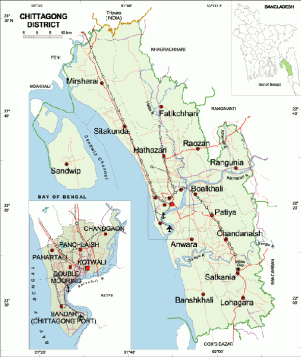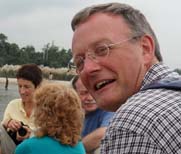
CHITTAGONG DIVISION: WHERE MOUNTAINS MEET THE SEA
GENERAL INFORMATION
 Chittagong Division is in the south eastern corner if Bangladesh. With an area of 33,771.13 square kilometer, it is bounded by Dhaka and Sylhet divisions and Tripura state of India on the north, Bay of Bengal and Arakan state of Myanmar on the south, Mizoram, Tripura states of India and chin state of Myanmar on the east and Bay of Bengal, Barisal and Dhaka divisions on the west. Approximately 24 million people of this division are 52.32% male and 47.97% female; Muslim 79%; Hindu 12.65%; Buddhist 7.08%; Christian 0.84% and others 0.43%.
Chittagong Division is in the south eastern corner if Bangladesh. With an area of 33,771.13 square kilometer, it is bounded by Dhaka and Sylhet divisions and Tripura state of India on the north, Bay of Bengal and Arakan state of Myanmar on the south, Mizoram, Tripura states of India and chin state of Myanmar on the east and Bay of Bengal, Barisal and Dhaka divisions on the west. Approximately 24 million people of this division are 52.32% male and 47.97% female; Muslim 79%; Hindu 12.65%; Buddhist 7.08%; Christian 0.84% and others 0.43%.Majority of this division is hilly. This division has Longest unbroken sandy sea beach of the world, the highest peak, only coral island, and biggest sea port of Bangladesh. We grow paddy, betel leaf, potato, cotton, tea, peanut, mustard, guard, brinjal, ginger, bean, Mango, jackfruit, pineapple, guava, coconut, betel nut, litchi, banana, papaya, water melon and lemon in this division.
This division is ideal for Trekking Tours, Walking Tours, Cycling Tours, Photography Tours, Culture tours, and Nature tours.
Chittagong is accessible by Air, Road, or Train as well.
MAJOR ATTRACTIONS
Chandranath Temple
Chandranath Temple located on top of the Chandranath hill is a famous shakti peeth located near Sitakunda in Chittagong where as per Hindu sacred texts the right arm of Goddess Sita fell. Sitakunda Chandranath Temple is a holy place of pilgrimage.
Shalban Vihara
It lies about the middle of the Lalmai ridge at Kotbari near Comilla. Excavations have exposed a large Buddhist monastery having cruciform foundation and four identical wings in four sides that looks similar to the excavated 8th century Buddhist at Paharpur. The site excavations have also brought other material objects datable from the 7th to 12th centuries AD.
Chatteshwari Temple
Located at the city centre, this Hindu temple is dedicated to Hindu Goddess Kali. Local people constructed this temple in the 18th Century. As the name refers, the goddess of the temple is the keeper of the town Chittagong, according to Hindu belief.
WWII cemetery
The War Cemetery on Badshah Mia Road is of historic interest. It contains the graves of 755 soldiers of the Allied Forces who laid down their lives on the Indo-Burmese front during World War II. Most of the soldiers buried there were from Australia, Britain, Canada, East and West Africa, British India and New Zealand. The total area of the cemetery is eight acres and it is protected and maintained by the Commonwealth War Graves Commission.
Ethnological Museum
The Chittagong Ethnological Museum, country’s lone ethnological museum, offers the visitors the chance to acquaint with the lifestyles and heritage of various ethnic groups of the country. It was established in 1965. The museum authorities had collected rare elements used in everyday lives of different ethnic groups, of which some had already become extinct while some were on the verge of extinction. The museum contains four galleries and a small hall.
Foy’s Lake
This is a man-made lake in Chittagong. The lake was dug by Assam-Bengal Railway engineer in 1924 and was named after the English engineer Mr. Foy. The lake is next to Batali Hill, the highest hill in Chittagong Metropolitan area. An amusement park is located here which features usual theme park rides and attractions as well as boat rides on the lake, landscaping, restaurants, concerts with floating stages, scenic walking trails and many other fun activities. The park includes a water theme park, resort and an amusement center.
Chittagong Sea Port
The Port of Chittagong is the largest seaport in Bangladesh, located by the estuary of the Karnaphuli River in Patenga, near the city of Chittagong. The main significance of this port lies in the fact that it provides a deep-water anchorage a few miles inland from the sea. The history of Chittagong port dates back to the fourth century BC. Chittagong derives its name from the Arabic word “Shetgang” (shet-Delta, Gang-the river). In the last fiscal year the port handled 2099 vessels with a historical increasing trend.
Alutilla Hill Cave
Alutilla, a high hill close to the town, is the great attraction of Khagrachari. There is approximately 100m long dark mysterious a cave inside the hill. A creek flows through the cave. From the top of Alutilla one can have a look onto the entire Khagrachari town, which is further facilitated by a watch tower.
Shubholong Bazaar
Shubholong is one of the most attractive scenic spots in Rangamati. Traditional boat is the only way to access the bazaar. Interestingly, the bazaar itself sets on little boats and is organized by the tribal people from the surrounding areas. Local products like banana, beans, pineapples etc are the items available in the market.
Rajbonobihar
This is a pretty modern Buddhist Pagoda located in the town. The live nature of the pagoda and serene environment is very soothing.
Cox’s Bazaar Sea Beach
Cox’s bazaar has the longest unbroken sandy sea beach of the world, which is 120km long stretching from Kalatoli to the southern land point at Teknaff. Magnificent sunset from the beach and marine drive to Himchari are among prime activities in the beach. The sun is mild throughout the year that makes the beach ideal for sunbath without fear of being sun burnt.
Burmese Market
This market is located in the Cox’s Bazaar town. It is mainly manned by Rakhain people, who came from Burma (Myanmar). Different types of pickles and handloom made by different indigenous people are mostly sold in the market.
Adinath Temple
Adinath Temple is a Hindu Temple dedicated to Lord Shiva. It is situated high up on a hill in the Moheshkhali Island; an hour’s boat ride from Cox’s Bazaar. The temple is famous for the annual 13 days long fair held in February at the foot of the Mainak Hill. This 17th Century temple as a magnificent view of the Bak Khali River, and has a refreshing environment.
Himchhari
Himchhari is a charming place with Sea in front of the hills, only 9km from the Cox’s Bazaar Town. The marine drive to Himchhari offers a superb experience for the nature lovers. There is a national park that has more than 50 species of trees and 250 species of birds. Climbing the hill of about 500 feet, one gets a wide view of the Bay of Bengal.
St. Martin's Island
St. Martin’s Island is the only Coral island of Bangladesh, located about 9km south to the Teknaff Beach. It is almost flat and is 3.6m above the mean sea level. The 9.66 km wide channel between the mainland and the island is much shallower than the open sea southwest of the island. The island is a little heaven for wildlife having 182 species of wildlife that includes 4 species of amphibians, 28 reptiles, 130 birds, and 20 mammals. Launches and country boats ply between the island and Teknaff regularly.
Chhera Dwip
Surrounding coral reef of the island gets cut off from its body during high tide and gets connected in low tide. Because of this nature of that extended island, it is called Chhera dwip (torn off Island). Visiting Chhera Dwip would be a memorable experience for those who are not familiar with the nature of sea.
Teknaff Game Reserve
Teknaff Game Reserve is a National Protected area of 11615 hectare situated on the hills of Teknaff thana of Cox’s Bazaar District. It was established in 1983. This is bounded by the Naff River from the east and by the Bay of Bengal from the west. From the hilltop of the game reserve, a tourist can enjoy the amazing scenic beauty of the river Naff, hill ranges of Mayammer and blue waves of the Bay of Bengal. The wild elephants, gibbon, hollock and other wild animals attract the tourists.
Ruma Bazaar
This is a traditional bazaar of local community and acts as a junction to highest hill accessible by motor vehicle Chimbuk, Second highest peak of Keokradong and the highest peak of Bangladesh Tajingdong.
Boga Lake
This is a lake at 1200 feet above sea level in the Ruma Thana of Bandarban district. According to the myth this lake is the home of a Dragon. Local name of this lake is "Bogakain" lake. It is 12acres in size. The water of the lake is crystal clear and under the water there are rocks and boulders all over. On the way to Tajingdong, this makes a nice refreshing stop for the trekkers.
Tajingdong
This is said to be the highest peak of Bangladesh having height of 4200 feet, which is about 160 feet higher than the previously claimed highest peak, Keokradong. The peak itself is interesting but more interesting are the villages on its way. You will encounter several friendly and jolly villages of tribal communities.
TOUR
South East Hills
This is the highest region of Bangladesh comprising three districts of the Chittagong Division. Winding road, lush greenery, and fresher air along with lake on the hills and indigenous people are the main attractions of the region.
View Details
This is the highest region of Bangladesh comprising three districts of the Chittagong Division. Winding road, lush greenery, and fresher air along with lake on the hills and indigenous people are the main attractions of the region.
View Details

Couple of district of the Chittagong division forms this region. Longest unbroken sandy sea beach of the world in Cox’s bazaar, and only Coral island of Bangladesh, St. Martin are the main attractions of this region.
View Details

Nature has always been open in beautifying Bangladesh in its own way. The land is naturally fertile, the river contains natural stream for its nature.
View Details

Bangladesh has the longest unbroken sandy sea beach of the world in Cox's Bazaar. That is not all, it has lot more beaches in the southern part of its territory. The sun is mild even in the summer that makes our beaches very attractive destinations for sunbathing.
View Details

Trekking is yet to be a mainstream tourist activity in Bangladesh despite its huge potential. However, this opens a door for you to trek into virgin destinations and discover new routs for next trekkers. Is it not exciting?
View Details

Drive in the morning to Mainamati to visit the excavated remains at the Shalban Vihara. Visit the Museum, Shalban Vihara, Itakhola Mura, and Charpatra Mura in the area. Have lunch at a local restaurant. Drive next to a place called Sonargaon to visit the ancient city . . .
View Details

















